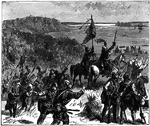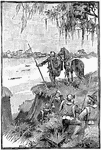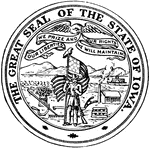Clipart tagged: ‘mississippi river’
Eads Bridge
St. Louis, Missouri is the home of the first rail and road bridge to cross the Mississippi River, the…

The Burial of de Soto
Hernando de Soto (Jerez de los Caballeros, Badajoz, Spain, c.1496/1497–May 21, 1542) was a Spanish…

De Soto Discovering the Mississippi River
Hernando de Soto (Jerez de los Caballeros, Badajoz, Spain, c.1496/1497–May 21, 1542) was a Spanish…

Fernando de Soto
Hernando de Soto (Jerez de los Caballeros, Badajoz, Spain, c. 1496/1497–May 21, 1542) was a Spanish…

Hernando De Soto Discovering the Mississippi River
This image portrays explorer, Hernando De Soto and other Conquistadors at the discovery of the Mississippi…

James Buchanan Eads
James Buchanan Eads (May 23, 1820 – March 8, 1887) was an American structural engineer and inventor.

Seal of Iowa
The Great Seal of the State of Iowa. The seal pictures a soldier in wheat field with the American flag…

Island Number Ten
Island Number Ten was a former island in the Mississippi River near Tiptonville, Tennessee and the site…

Bombardment of Island Number Ten
Island Number Ten was a former island in the Mississippi River near Tiptonville, Tennessee and the site…

The Great Naval Battle of the Mississippi
Passage of the second division of the Federal Squadron past Fort St. Philip. On April 24, 1862 at three…

The Great Naval Battle on the Mississippi
First day's bombardment, Federal Schooners off Forts Jackson and St. Philip, commanding the passage…

Port Eads
Port Eads, Louisiana, is located at the southern tip of the Mississippi River, also known as South Pass…

Hernando de Soto
A Spanish explorer and conquistador who was the first European documented to have crossed the Mississippi…

